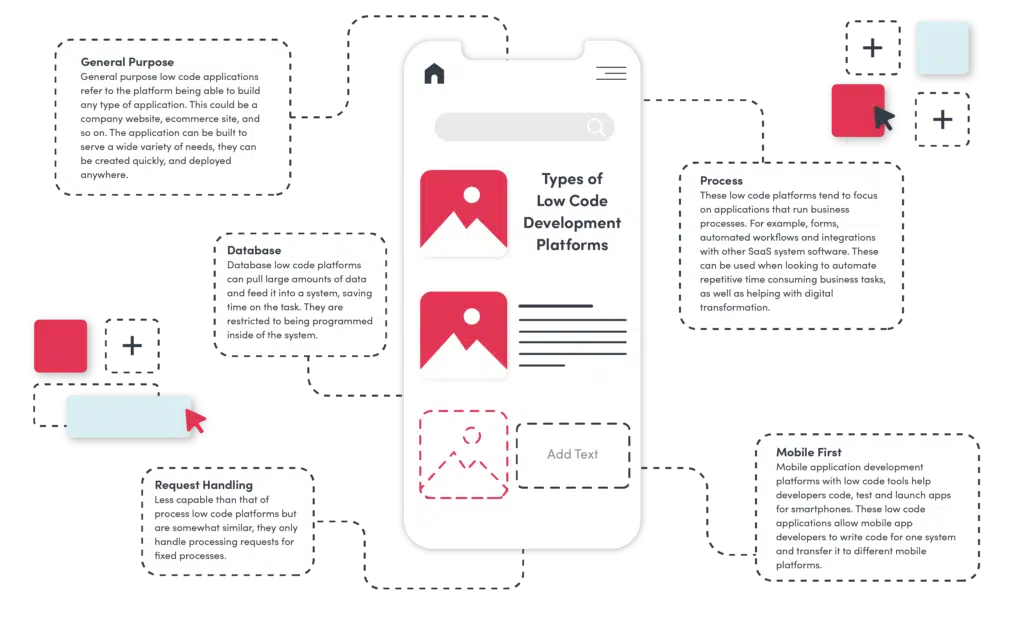Visual Development Environment:
Drag-and-Drop Interfaces: Low-code platforms provide visual tools for designing applications. Developers can quickly assemble an application using drag-and-drop elements without writing code.
Templates and Components that are pre-built: Many platforms that allow low-code support come with templates and components that are pre-built that allow developers to build prototypes quickly and develop applications without starting entirely from the beginning.
Reduced Coding Requirements:
Automated Code Generation: The low-code platform generates the code underneath based upon the visual models that developers design. This reduces the need to code manually and accelerates the development process.
Reusable Parts: Developers will have the ability to reuse parts that are reusable across their projects, thereby reducing the time needed for writing and testing code.
Collaboration streamlined:
Low-code platforms include many tools that allow seamless collaboration between development teams. They can be used for testing, version control, and deployment.
Citizen Development: Non-developers and business users can use user-friendly interfaces to aid in the creation of applications, which helps reduce bottlenecks triggered by a shortage of professional developers.
Rapid Iteration, Prototyping:
Fast prototyping: Developers are able to quickly create prototypes in order to collect feedback and confirm concepts, which leads to faster iterations.
Easy Modifications: The visual nature of low-code development makes it easier to make modifications and updates to applications. This speeds up the process of improving and refining applications based on user feedback.
Pre-built Integrations:
API Integrations: Low-code platforms usually have pre-built connectors for popular services and APIs, reducing the time required to integrate external systems.
Data Integration: Built-in tools for data integration simplify the connection to databases and other data sources. This speeds up development.
The deployment of scaling:
One-Click-Deployment: Many Low-Code platforms provide one-click deployment options. This can reduce the time and efforts required to deploy an application.
Cloud-based solution: Cloud based low code platforms are capable of handling infrastructure management and scaling. This lets developers concentrate on applications' logic, functions and features instead of the logistics of deployment.
Low-code application development is a quicker method to create apps. It streamlines and automates many aspects of the procedure. This enables faster delivery and adapting to the changing needs. Read the most popular Low-code Platform for application development tips for blog advice including cross platform mobile app development, sso azure, mobile development platforms, azure sql databases, azure sql databases, app development platform, push notifications android, jdbc server, ms azure sql, database in azure and more.

Benefits Of Low-Code Application Development In Governance And Security
Low-code development can bring many advantages regarding security and governance. They are essential to ensure that apps are secure, compliant and properly managed throughout their lifecycle. These are the main benefits.
Unified Management Console: This low-code platform usually provides a central dashboard for administrators to control and monitor all applications, ensuring consistency governance across the organisation.
Role-Based Access Control RBAC: These platforms come with powerful role-based controls that permit administrators to establish access policies. Only authorized users will be permitted to modify and access certain parts of the application.
The Compliance Process and Regulatory Adherence:
Built-in Compliance Features: A lot of low-code applications are designed to be compliant with the industry norms as well as regulations (e.g., GDPR, HIPAA). These platforms have frameworks and tools to make sure that the applications are compliant to these standards.
Audit Trails: Organizations often use comprehensive log and audit trail systems that allow the organization to monitor changes make, track access and assure that they are in compliance with internal as well as external laws.
Increased Security Measures
Data Encryption Low-code platforms often come with built-in encryption of information in transit and at rest, which protects sensitive information.
Security Certificates: Many low-code providers have a security certificates (e.g. ISO 27001 and SOC 2) which demonstrate their adherence to strict security standards. They also provide an extra degree of security to customers.
Automated Security Updates:
Regular updates and patches Low-code platforms are typically equipped to handle security patches and updates on a regular basis. This means that apps remain safe from the latest threats without the need for developers to manually alter their settings.
Security Monitoring - Continuous monitoring for security is often included. It provides real-time insight and alerts about potential security threats.
Data Governance:
Data Access Policy: These platforms let companies define and enforce rules for data access, making certain that only authorized users have access to data and that it is used properly.
Data Masking and anonymization: The built-in tools to mask and anonymize data help protect sensitive information when working in testing or development environments.
Consistent Application Management
Pipelines for development and delivery: Low-code platforms typically include integrated development pipelines and delivery pipelines which incorporate security tests. Security is ensured throughout the entire lifecycle.
Version Control - Integrated version controls helps keep track of modifications to applications and allow the application to be reversed when needed. They also ensure the integrity and performance of the software.
User Authentication and Authorization:
Single Sign-On (SSO): Single sign-on support and other advanced authentication mechanisms simplify management of users and improves security.
Multi-Factor Authentication Most platforms can support multi-factor Authentication that adds an extra layer to security when accessing applications.
Policy Enforcement and Compliance monitoring:
Low-code platform often comes with templates for policies that are pre-defined to enable organizations to implement cybersecurity and governance policies quickly.
Compliance Monitoring Tools: They give continuous monitoring and a report on the status of compliance. This makes it easier to spot potential problems and tackle them in a timely manner.
Integrating with Existing Security Infrastructure
Seamless Integration: Platforms with low-code have been designed to seamlessly integrate with the existing tools and infrastructure, such as SIEM (Security Information and Event Management solutions) and firewalls.
API Security: API integrated security ensures integrations with external systems are secured. Secure data and ensure the consistency of your application.
Best Practices and Training:
Best practices: Many platforms have guidelines for the development of secure apps, as well as best practices. This helps non-developers to adhere to security standards.
Security Training Some low-code providers offer security resources and training to users in order to help them understand how to create and maintain secure applications.
Overall, the application's governance and security advantages ensure that applications will be built and managed securely and in accordance with regulations, and under control. These platforms have the tools, frameworks and regulatory compliance needed to secure sensitive data of customers and enforce policy. They also maintain regulatory conformity as well as simplifying the management of and oversight over the application development process. Check out the most popular Enterprise application development with Low-code Platform for blog advice including app development platform, rapid action development, ms azure sql, app platforms, no code platforms, paas service, application modernisation, low code development platforms, cross platform mobile app development, rapid app development and more.

Advantages Of Low-Code Application Development In Terms Of Support From Vendors And Community
Low-code platform development provides significant advantages, such as vendor support and community. This is vital for ensuring the success of application implementation, ongoing maintenance and continuous improvement. Here are the major advantages: Support from vendors
Comprehensive Technical Support:
Dedicated Support Teams Numerous low-code platforms provide dedicated support teams who can help with technical issues, problem-solving and provide guidance. This helps ensure that any issues will be quickly resolved.
Certain vendors offer support 24 hours a day. This can be very beneficial for businesses who operate in different time zones.
Training and Onboarding
The structured training programs offered by vendors offer structured courses like webinars and certification courses. This helps users quickly grasp the platform.
Customized Onboarding A lot of vendors offer customized services that help new customers get onboard efficiently and adapt it to their requirements.
Regular updates and enhancements
Continuous improvement: Low-code platforms generally release updates regularly which contain the latest features, performance enhancements as well as security patches, ensuring that the platform stays modern and safe.
Feedback Integration: Vendors often include feedback from users into their development cycles, making sure that the platform evolves to meet the evolving needs of its users.
Comprehensive Documentation:
Comprehensive Documentation: A comprehensive and well-organized documentation is typically available, covering everything from basic usage to advanced customization, which helps users to find solutions without assistance.
API References: Comprehensive API documentation helps developers integrate the low-code platform into other systems and tailor their applications efficiently.
Professional Consulting Services
Expert Consulting: Many companies offer consulting services to assist users in complex implementations and designs for architecture and strategic planning.
Custom Development Services Certain companies offer custom development services to help with specific functions or integrations that aren't available out of the standard package.
Community Support
Active User Groups:
Discussion boards and forums: Many platforms with low-code have vibrant online community where users can seek help, share solutions and collaborate in finding the best practices.
User Groups and Meetups: Virtual and local user groups and meetups offer opportunities to learn about, network, and share experiences with other users.
Knowledge Sharing and Collaboration:
Community-Contributed Resources: Users often share templates, modules, and extensions that they have developed, which can be reused or adapted by others, accelerating development and innovation.
Crowdsourced problem solving The collective knowledge and experience of the crowd is an excellent resource when it comes to tackling problems and coming up with creative solutions.
Learning and development:
Community-Led Learning: Several communities host workshops, training sessions and webinars that are often led by users with experience who can provide insights and more advanced methods.
Online Tutorials and Courses Community members usually create and distribute online courses, tutorials, and how-to guides, making better educational resources available to all users.
Feedback and Influence
Product Feedback Channels. Community forums typically include channels where you can provide feedback to the vendor. This feedback may influence the design and development of new features.
Beta Testing: Members of active communities may have an opportunity to participate. This allows them to get early access and participate in the development of the platform.
Recognition and encouragement:
Community Recognition Programs: Many companies offer recognition programs to active community members. Some examples include MVP (Most Valuable Professionals) that recognizes contributions of the community.
Peer Support: Community members provide peer support to others by sharing their experiences and providing advice. They create a collaborative and supportive atmosphere by sharing their knowledge.
Overall, the combination of robust vendor support and an active connected community offers a comprehensive support ecosystem for development of low-code applications. It ensures users have the expertise, resources and collaboration opportunities to successfully develop and implement their apps.
